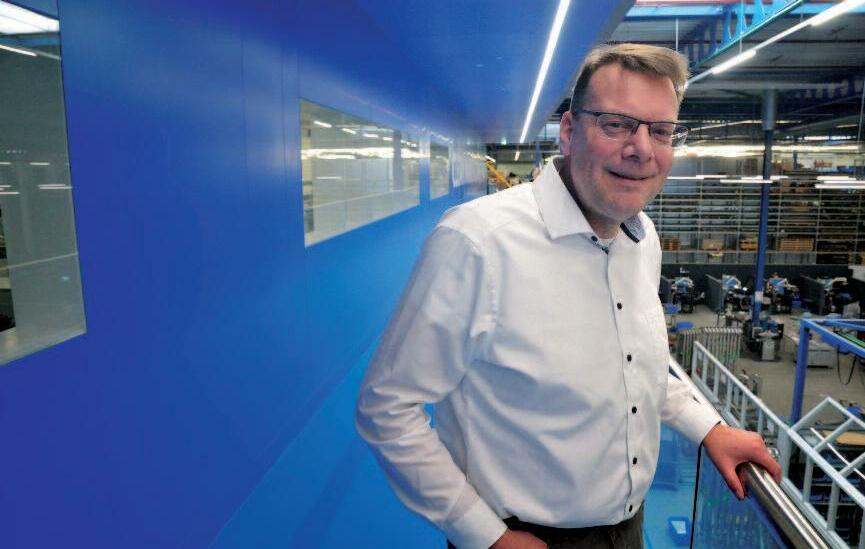HUMAN RELATIONS
WITH ‘TRIBE THINKING’, SIOUX IS COMMITTED TO SOLID GROWTH ON ITS OWN CAMPUS AND ELSEWHERE IN THE WORLD
‘IN THE GAME OF ATTRACTING EMPLOYEES, YOUR OWN IDENTITY IS CRUCIAL’ Sioux Technologies was founded more than 25 years ago as a specialist in technical software. Electronics and mathematics were added later. It is now the largest independent technical system unit in the Benelux, with competencies such as mechatronics, optics, system engineering, prototyping and assembly. High-tech customers can contact them for anything, from concept to serial production. At the main location, this is now all happening on one campus with seven buildings in the north of Eindhoven. Blood groups are not important. ‘The point is that technicians build very beautiful things together.’ says Giesen. When the lockdown was over, he immediately got a disc jockey in.
BY LUCY HOLL
I
t’s about twelve o’clock. A whole procession of employees walks to Sioux Labs, the central meeting place on the Sioux site. Above the door, twinkling lights that spell ‘Entrance’. The set-up is deliberately casual and pleasant, says Leon Giesen, who is responsible for the day-to-day management of the European Sioux branches, together with founder Erik van Rijswijk. Co-founder Hans Duisters focuses entirely on the Asian market. ‘Club House’ Sioux Labs is where people meet and discuss each other, and where customers, students, schoolchildren and many more external parties gather for various meetings. Where you find pizza boxes lying around or the remnants of a barbecue, and where ‘bitterballen’ and beer flow freely on Friday. Home-brewed ‘Sioux’ beer, that is. ‘Unfortunately, we couldn’t really organise anything at Sioux Labs in the last two years’,
ECOSYSTEM Leon Giesen is a member of several boards, he states on LinkedIn. He is also chairman of the supervisory board of MGG, a manufacturer of aluminium castings and assemblies, member of the supervisory board of Frencken Mechatronics and member of the advisory board of Cuyten Maintenance Service. They don’t bite each other, he says. ‘It’s actually a very good thing to do. I contribute my experience and see how other companies operate and where they are heading. It’s mutually enriching. Don’t just focus on your own business, we’re all part of a larger ecosystem.’
24
IN-HOUSE DISCIPLINES Sioux Technologies has grown strongly in recent years, with the acquisition of mechatronics expert CCM from Nuenen in 2014 being one of the major strategic steps. Leon Giesen: ‘We have thus moved from mono to multidisciplinary. It’s important to have your own assembly competencies, aimed at industrialisation and serial system integration. That enables you to properly guide the transition from pure R&D to production. Sioux wants to be good at prototypes, one-offs, series and complete Life Cycle Management. That requires a single organisation that’s no longer about software, mathematics or mechatronics as separate units. Sioux Technologies is one multidisciplinary system unit. With all our disciplines we can design, build and integrate the most complex machines and modules in their entirety.’ For each project, employees with the most appropriate competencies are put together.
OVERFISHED POND The embedded software branch was already located in the north of Eindhoven. There was land, more buildings were built and that is how the Sioux campus was created. ‘We can build on our own image here. A branch in Brainport has many advantages, but the region is an overfished pond: in the game of attracting and retaining employees, your own identity is crucial. Sioux is all about fun & value: this is a nice company with challenging work. People can grow and increase their market value. Outside of work, there’s also a lot of attention for them, which benefits both
Special High-tech The Netherlands - April 2022
employees and the company.’ The name Sioux comes from an Indian tribe. At the time, founders Duisters and Van Rijswijk chose to oppose the Western focus on shareholder value. They put people first and wanted to focus on standards and values. Giesen: ‘Tribe thinking is popular these days, but we’ve been doing it for years: people and culture are important. There’s nothing artificial about it, that’s how it evolved. It also applies to branches elsewhere in the world. It’s in the DNA.’
GUINNESS BOOK OF RECORDS Sioux Technologies (turnover last year more than 100 million, this year probably 120-125 million) now has about 1,000 employees, including 75 in assembly and the vast majority in development and engineering. This includes many highly skilled people with a Master’s or PhD background. The company has branches in Mijdrecht, Apeldoorn and Delft and in China, Belgium, Germany, Russia, Romania, Singapore and Vietnam. All those cultures, blood groups and disciplines work together just fine, says Giesen. ‘No arguments during projects. Technicians want to build very beautiful things together and for that, they need each other. That’s their motivation.’ Take the Ultra-X, a high-precision and fast detection system for the Spectra Ultra S/TEM, the high-end transmission electron microscope from Thermo Fisher Scientific. ‘It’s regarded as one of the most complicated systems ever built. The Ultra-X technology is a breakthrough that could win Nobel prizes, so to speak. It landed us in the Guinness Book of Records. Our people are very, very proud of that.’ No-one mentions his exact background or from which Sioux branch he descends.












